 |
|
 |
 |
 |
Cingshueiyan Scenic Area |
 |
It is located in the foothills of Fonghuang Mountain in Tantou Village (Tantou Mountain), the formation of coral limestone is one of the Eight Wonders of Kaohsiung State during Japanese Occupation, including the 300 years old Cingshuei Temple; the lush mountain is a great hiking location.
Get off from Expressway No.88 and follow Fonglin Road, pass Daliao Township and enter Linyuan Township, soon you will see Cingshueiyan Road on the right.
The several hundred meters of road from the entrance to the temple has been renovated by the Township Office to become a tidy and bright scenic road. |
 |
 |
Cingshuei Temple |
| |
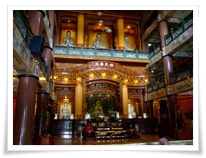 It is located under Cingshueiyan in Tantou Village, the worship circle encompasses the entire Linyuan Township and part of the villages in Daliao Township, it is a very important local religious center. It is located under Cingshueiyan in Tantou Village, the worship circle encompasses the entire Linyuan Township and part of the villages in Daliao Township, it is a very important local religious center.
If you enter from the arch entrance, to the right is the spacious parking lot, if you look towards the direction of the temple, you will see a solemn statue of Ksitigarbha Bodhisattva.
Next to the Jilege Bone Storage Hall, legend has it that there was a feng shui expert called Lin Jhen-sian (also known as Lin Ban-sian), while checking the fongshuei in order to pray for irrigation water for the farmers, he setup an alter and waved his sword to cast a spell. When he plunged the sword into the ground the spring water gushed out, water still runs out of the site even today. It is a pity that it is now a restricted military area, no entrance and photography is allowed.
Cingshuei Temple was built in 1666, it worships the Sakyamuni Buddha and Avalokiteśvara, with over four centuries of history. Due to its long lasting history and great number of followers, the stories of Avalokiteśvara’s divine manifestation and saving the world are continuously passed down the generations, and truly astonishing.
|
| |
 |
Temple-side Delicacy: Tea Leaf Boiled Eggs |
| |
|
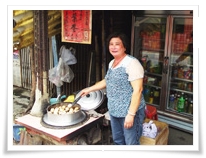 The tea leaf boiled egg stall on Cingshueiyan Road outside Cingshuei Temple has been in business for over 40 years; the eggs are prepared according to an ancient recipe; Chinese herb sachets, tea leaves and special ingredients are added and boiled to perfection over a wood fire, giving it a unique flavor. The tea leaf boiled egg stall on Cingshueiyan Road outside Cingshuei Temple has been in business for over 40 years; the eggs are prepared according to an ancient recipe; Chinese herb sachets, tea leaves and special ingredients are added and boiled to perfection over a wood fire, giving it a unique flavor. |
 |
 |
Cingshueiyan Mountain View |
| |
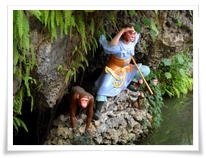 During the Japanese Occupation, Cingshueiyan was one of the Eight Wonders of Kaohsiung State, which offers picturesque landscapes and pleasant sceneries. One needs to walk to reach the scenic area; for people who are from out of town, the fastest shortcut is to walk directly up the stairs next to the temple. During the Japanese Occupation, Cingshueiyan was one of the Eight Wonders of Kaohsiung State, which offers picturesque landscapes and pleasant sceneries. One needs to walk to reach the scenic area; for people who are from out of town, the fastest shortcut is to walk directly up the stairs next to the temple.
At the entrance there is a century old red cedar tree; after you enter, there are sculptures of Avalokiteśvara on both side s of the path. The pond on the side has the writings of Shueilian Cave, while the lifelike statues of Chi Tian Da Sheng and the monkey are next to the pond. |
| |
 |
Longpan Cave |
| |
|
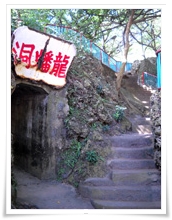 It is situated on the Fongshan Hill and is the tunnel ruins from the Japanese Occupation period, where the Japanese Army recruited local citizens to construct the tunnel. It is situated on the Fongshan Hill and is the tunnel ruins from the Japanese Occupation period, where the Japanese Army recruited local citizens to construct the tunnel.
According to local senior citizens, the tunnel passes from the Fongshan Reservoir in Linnei Village, through Cingshueiyan to Fongbitou in Jhongmen Village. The convoluted tunnel is safer in the Longpan Cave area, however one should wear special gear and do not leave litter in the tunnel.
Legend has it that in addition to the Longpan Cave, there are roughly 30 scenic spots such as “Frog teases the Tiger", “Dazzling Sun and Moon”, “Taoyuan Cave”, “Umbrella Pavilion”, “Statue of Chencheng” etc., visitors can follow the stairs and signs to explore the area.
The lush green mountain and winding stairs are interesting to explore; there are many bird species on the mountain, including White-eye.
When you are tired of walking, there are many pavilions to take a rest, with the cool wind blowing in the face, the beauty of Linyuan Township is clearly visible in the distance, as well as Liouciou Island and Dawu Mountain in Hengchun. |
| |
 |
Local Handicrafts |
| |
|
 From the beginning of the Republic to the 1960s, the broom industry in Linnei Village flourished. With changes in time, currently only two manufacturers remain: the old couple Liou Neng-sian and Li Ji-syong, who live in Lane 112 and Lane 93 of Linnei Road respectively. From the beginning of the Republic to the 1960s, the broom industry in Linnei Village flourished. With changes in time, currently only two manufacturers remain: the old couple Liou Neng-sian and Li Ji-syong, who live in Lane 112 and Lane 93 of Linnei Road respectively.
The Kanglang broom was also called Tiandi broom, it is used to drive out evil spirits and is purchased in pairs not individually, it is however produced individually not in pairs, modern people buy the broom to drive away evil spirits and all things bad, and to bring in all things auspicious and for Tocolysis. |
 |
 |
Fongshan Reservoir |
 |
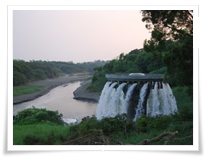 The Fongshan Reservoir falls under the jurisdiction of the Fongshan Water Supply Plant in the Seventh Administrative Office of the Taiwan Water Corporation. The water conservancy area covers an area of 275 hectares, including Linyuan Township, Daliao Township and Kaohsiung’s Siaogang District. The dam is 74.9 hectares and has a capacity of 8.7 million tons. The Fongshan Reservoir falls under the jurisdiction of the Fongshan Water Supply Plant in the Seventh Administrative Office of the Taiwan Water Corporation. The water conservancy area covers an area of 275 hectares, including Linyuan Township, Daliao Township and Kaohsiung’s Siaogang District. The dam is 74.9 hectares and has a capacity of 8.7 million tons.
The ecology at Fongshan Reservoir is diverse and its surrounding area is a popular place for walking and cycling. Entrance into the reservoir area requires approval by the management authority. |
 |
The Hometown of Phalacrocoracidae |
| |
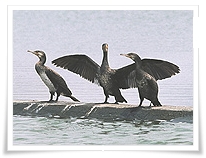 The Fongshan Reservoir is a water conservancy area, under the maintenance of the Taiwan Water Corporation; since there have been little human disturbances, it has become a sanctuary for wild birds. According to research by the Kaohsiung Wild Bird Society, the bird species that have been observed here include: resident birds, winter/summer migratory bird, migratory bird, foreign bird and vagrant bird. There are at least 97 species from 29 families of birds here; in particular, 772 Phalacrocoracidae were recorded in mid-October 1997 and 2176 Phalacrocoracidae were documented in 2002, making Fongshan Reservoir the largest nocturnal habitat for Phalacrocoracidae in Taiwan. The Fongshan Reservoir is a water conservancy area, under the maintenance of the Taiwan Water Corporation; since there have been little human disturbances, it has become a sanctuary for wild birds. According to research by the Kaohsiung Wild Bird Society, the bird species that have been observed here include: resident birds, winter/summer migratory bird, migratory bird, foreign bird and vagrant bird. There are at least 97 species from 29 families of birds here; in particular, 772 Phalacrocoracidae were recorded in mid-October 1997 and 2176 Phalacrocoracidae were documented in 2002, making Fongshan Reservoir the largest nocturnal habitat for Phalacrocoracidae in Taiwan.
|
|
 |
|
|